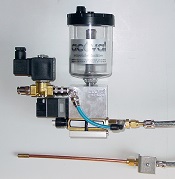
Microlubrication which is also named minimum quantity lubrication (MQL) is a means to bring accurate quantity of liquid in a process.
Microlubrication principles
- Difference between microlubrication and spraying
- Microlubrication system components
- Management of micropumps
- Nozzles
- Differences between microlubrication systems
Difference between microlubrication and spraying
These two technologies are able to spray liquids. Means to adjust the liquid flow are different:
| Microlubrication systems | Spray systems: liquids are sprayed by a gas | Spray systems: liquids are sprayed without a gas |
||||
|---|---|---|---|---|---|---|
| with coaxial tubes | with single tubes | a pump feeds the nozzles with liquid | nozzles suck the liquid up | |||
| Liquid flow production | Each nozzle is fed by a micropump | A pump feeds all nozzles. | Nozzles suck the liquid up with a gas. | Each nozzle is fitted with a pump | ||
| Flow adjustment |
| by adjustable jets | With nozzles:
|
|||
| Nozzles are fed with |
| a mist made up near the micropump |
|
a gas which sucks the liquid up from another intake. | something from which the pump sucks the liquid up | |
| Spraying thinness | is adjustable by:
| Nozzles throw a mist | is adjustable by:
| Nozzles generate mist | is adjustable by:
|
|
| Advantages | It is easy to manage each thinness and each little flows. | A micropump can feed several nozzles. | It is easy to manage the thinness. | It is cheap. |
| |
| Drawbacks | Each nozzle requires a micropump. |
| the cost |
| Results when the liquid flow is low | |
| Devices | Instantaneous lubrication systems | Continuous lubrication systems | Spray nozzles | (top) | ||
without a cabinet |
without a cabinet | |||||
in a cabinet |
in a cabinet | |||||
Some nozzles may be used with microlubrication systems or spray system.
Microlubrication system components
| Essential components | Optional components | ||
|---|---|---|---|
| for all systems | a tank | a cabinet | |
| an attachment magnet under the system | |||
| one or several | micropump | attachment magnet for nozzle | |
| single or coaxial tube | quick coupling | ||
| nozzle or connector | |||
| for continuous systems | a sequencer | a tap | |
| a solenoid valve | |||
| for instantaneous systems | a solenoid valve | ||
When a system is fitted with several micropumps, switches may be provided to select working micropumps.
Management of micropumps
Adjustement of capacities
Most micropumps are fitted with a device to adjust their capacities. It may be a screw or spacers.
The driving
As microlubrication micropumps are volumetric using a piston, they push an amount of liquid each time they are activated. So it is necessary to distinguish two cases:
| The need | one amount of liquid | a continuous flow |
|---|---|---|
| Constraint |
| It is necessary:
|
| System type | Instantaneous microlubrication system | Continuous microlubrication system (top) |
| Devices | without a cabinet |
without a cabinet |
in a cabinet |
in a cabinet |
Nozzles
There are several kinds of nozzles:
- nozzles which spray the liquid on a circular area
- nozzles which focus the liquid
- nozzles which produce a flat jet
- nozzles for specific processes. (top)
Differences between microlubrication systems
Two microlubrication systems with same characteristics may not give same results because:
- there are differences between micropumps
- each manufacturer produces its nozzles
- the cabinets are different
- and so on.
These differences involve that:
- nozzles do not focus or spray liquid with the same efficiency
- the liquid flow regularity is not the same
- all microlubrication systems cannot process all liquids. (top)
 Français
Français